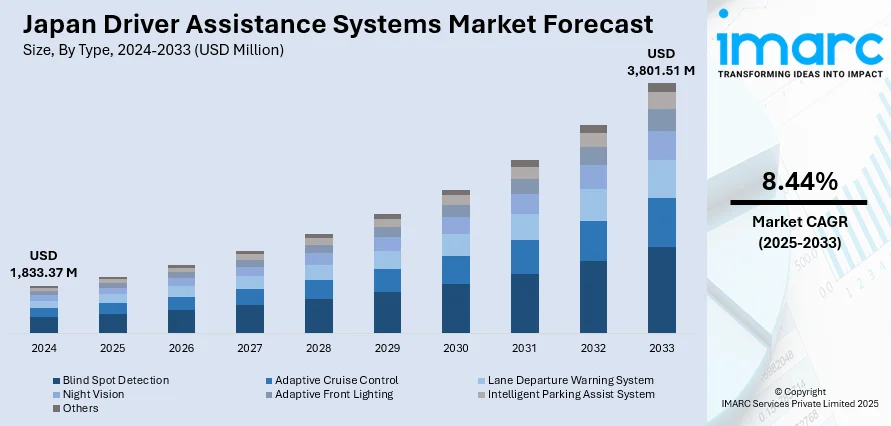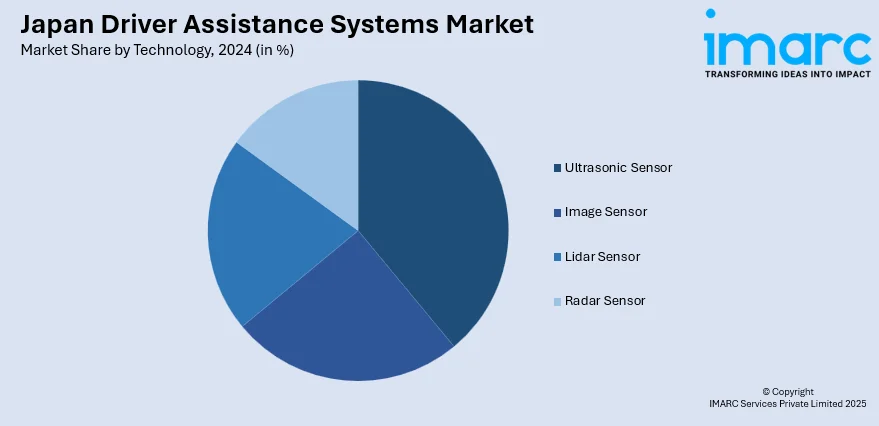
Japan Driver Assistance Systems Market Size, Share, Trends and Forecast by Type, Technology, Vehicle Type, and Region, 2025-2033
Japan Driver Assistance Systems Market Overview:
The Japan driver assistance systems market size reached USD 1,833.37 Million in 2024. Looking forward, IMARC Group expects the market to reach USD 3,801.51 Million by 2033, exhibiting a growth rate (CAGR) of 8.44% during 2025-2033. At present, the increasing demand for technologies that help reduce accidents and enhance driving comfort is offering a favorable market outlook. Besides this, the growing adoption of electric vehicles (EVs) for environmental and economic reasons is contributing to the expansion of the Japan driver assistance systems market share.
|
Report Attribute
|
Key Statistics
|
|---|---|
|
Base Year
|
2024 |
|
Forecast Years
|
2025-2033
|
|
Historical Years
|
2019-2024
|
| Market Size in 2024 | USD 1,833.37 Million |
| Market Forecast in 2033 | USD 3,801.51 Million |
| Market Growth Rate 2025-2033 | 8.44% |
Japan Driver Assistance Systems Market Trends:
Growing awareness about road safety
The rising awareness among the masses about road safety is positively influencing the market. As drivers and passengers are becoming more conscious about the risks associated with traffic collisions, they seek vehicles equipped with features that offer proactive safety. Advanced driver assistance systems, such as blind-spot detection and automatic emergency braking, are gaining popularity for their ability to prevent human error. In Japan, the government and auto manufacturers are promoting these technologies as part of national safety campaigns and regulatory measures. People are showing high interest in cars that offer not only convenience but also active protection. Consequently, automakers are investing heavily in integrating driver assistance systems into both new models and affordable vehicle segments. Insurance companies are also contributing by offering lower premiums for vehicles with safety systems, further encouraging adoption. Rapid urbanization activities and increasing traffic congestion in Japanese cities are creating the urgency for better safety tools, especially for older drivers, who form a significant part of the population. As per industry reports, in 2024, Kyoto ranked 6th worldwide for being the slowest nation on roads, averaging 33 minutes and 16 seconds per 10 km, which marked a 20-second rise since 2023. The city's congestion level of 39% led to a yearly time loss of 95 hours, giving it a worldwide congestion ranking of 60. Public education programs, along with media coverage of traffic incidents, continue to boost awareness about the importance of safety technologies.

Increasing adoption of EVs
The rising adoption of EVs is impelling the Japan driver assistance systems market growth. As more people are employing EVs for environmental and economic reasons, automakers are equipping these vehicles with modern driver assistance systems to enhance their appeal. EVs often come with the latest technological features, including automatic emergency braking, adaptive cruise control, lane keeping assistance, and parking sensors, which improve both safety and comfort. The quiet operation and innovative design of EVs make them ideal platforms for integrating advanced driver assistance system technologies. Japanese users, known for valuing innovations and efficiency, are showing strong interest in smart driving solutions. Government incentives for EV purchases and stringent emissions regulations are further encouraging this transition, which in turn is driving the demand for modern safety systems. Additionally, the ongoing shift toward autonomous driving aligns closely with the growing EV market, as both trends rely on sensor-based technologies and real-time data processing. Moreover, international companies are expanding their retail network in the country, strengthening the market. In April 2025, Chinese electric vehicle producer BYD planned to grow its retail network in Japan to 100 stores, up from more than 60 sites.
Japan Driver Assistance Systems Market Segmentation:
IMARC Group provides an analysis of the key trends in each segment of the market, along with forecasts at the country and regional levels for 2025-2033. Our report has categorized the market based on type, technology, and vehicle type.
Type Insights:
- Blind Spot Detection
- Adaptive Cruise Control
- Lane Departure Warning System
- Night Vision
- Adaptive Front Lighting
- Intelligent Parking Assist System
- Others
The report has provided a detailed breakup and analysis of the market based on the type. This includes blind spot detection, adaptive cruise control, lane departure warning system, night vision, adaptive front lighting, intelligent parking assist system, and others.
Technology Insights:

- Ultrasonic Sensor
- Image Sensor
- Lidar Sensor
- Radar Sensor
A detailed breakup and analysis of the market based on the technology have also been provided in the report. This includes ultrasonic sensor, image sensor, lidar sensor, and radar sensor.
Vehicle Type Insights:
- Passenger Cars
- Light Commercial Vehicles
- Heavy Commercial Vehicles
The report has provided a detailed breakup and analysis of the market based on the vehicle type. This includes passenger cars, light commercial vehicles, and heavy commercial vehicles.
Regional Insights:
- Kanto Region
- Kansai/Kinki Region
- Central/ Chubu Region
- Kyushu-Okinawa Region
- Tohoku Region
- Chugoku Region
- Hokkaido Region
- Shikoku Region
The report has also provided a comprehensive analysis of all the major regional markets, which include Kanto Region, Kansai/Kinki Region, Central/Chubu Region, Kyushu-Okinawa Region, Tohoku Region, Chugoku Region, Hokkaido Region, and Shikoku Region.
Competitive Landscape:
The market research report has also provided a comprehensive analysis of the competitive landscape. Competitive analysis such as market structure, key player positioning, top winning strategies, competitive dashboard, and company evaluation quadrant has been covered in the report. Also, detailed profiles of all major companies have been provided.
Japan Driver Assistance Systems Market News:
- In January 2025, 5-door Maruti Suzuki Jimny Nomade was introduced In Japan. It featured level-2 advanced driver assistance systems, including a collision avoidance system and adaptive cruise control. It was equipped with heated outside rearview mirrors (ORVMs) that had two small mirrors on the bottom to minimize blind spots and aid when venturing off-road.
- In October 2024, the Automated Driving Alliance, a collaboration between Bosch and Volkswagen’s subsidiary CARIAD, began testing its automated driving technologies in Japan. The initial Volkswagen ID.Buzz units were set to begin test driving in the country by the middle of the month. The ID.Buzz cars came with advanced technology to manage intricate traffic scenarios in real-world conditions. The vehicles were equipped with multiple cameras, radars, and a central computing system that captured all pertinent data. Moreover, specialized measurement technology was utilized to facilitate a thorough assessment.
Japan Driver Assistance Systems Market Report Coverage:
| Report Features | Details |
|---|---|
| Base Year of the Analysis | 2024 |
| Historical Period | 2019-2024 |
| Forecast Period | 2025-2033 |
| Units | Million USD |
| Scope of the Report |
Exploration of Historical Trends and Market Outlook, Industry Catalysts and Challenges, Segment-Wise Historical and Future Market Assessment:
|
| Types Covered | Blind Spot Detection, Adaptive Cruise Control, Lane Departure Warning System, Night Vision, Adaptive Front Lighting, Intelligent Parking Assist System, Others |
| Technologies Covered | Ultrasonic Sensor, Image Sensor, Lidar Sensor, Radar Sensor |
| Vehicle Types Covered | Passenger Cars, Light Commercial Vehicles, Heavy Commercial Vehicles |
| Regions Covered | Kanto Region, Kansai/Kinki Region, Central/Chubu Region, Kyushu-Okinawa Region, Tohoku Region, Chugoku Region, Hokkaido Region, Shikoku Region |
| Customization Scope | 10% Free Customization |
| Post-Sale Analyst Support | 10-12 Weeks |
| Delivery Format | PDF and Excel through Email (We can also provide the editable version of the report in PPT/Word format on special request) |
Key Questions Answered in This Report:
- How has the Japan driver assistance systems market performed so far and how will it perform in the coming years?
- What is the breakup of the Japan driver assistance systems market on the basis of type?
- What is the breakup of the Japan driver assistance systems market on the basis of technology?
- What is the breakup of the Japan driver assistance systems market on the basis of vehicle type?
- What is the breakup of the Japan driver assistance systems market on the basis of region?
- What are the various stages in the value chain of the Japan driver assistance systems market?
- What are the key driving factors and challenges in the Japan driver assistance systems market?
- What is the structure of the Japan driver assistance systems market and who are the key players?
- What is the degree of competition in the Japan driver assistance systems market?
Key Benefits for Stakeholders:
- IMARC’s industry report offers a comprehensive quantitative analysis of various market segments, historical and current market trends, market forecasts, and dynamics of the Japan driver assistance systems market from 2019-2033.
- The research report provides the latest information on the market drivers, challenges, and opportunities in the Japan driver assistance systems market.
- Porter's five forces analysis assist stakeholders in assessing the impact of new entrants, competitive rivalry, supplier power, buyer power, and the threat of substitution. It helps stakeholders to analyze the level of competition within the Japan driver assistance systems industry and its attractiveness.
- Competitive landscape allows stakeholders to understand their competitive environment and provides an insight into the current positions of key players in the market.
Need more help?
- Speak to our experienced analysts for insights on the current market scenarios.
- Include additional segments and countries to customize the report as per your requirement.
- Gain an unparalleled competitive advantage in your domain by understanding how to utilize the report and positively impacting your operations and revenue.
- For further assistance, please connect with our analysts.
 Request Customization
Request Customization
 Speak to an Analyst
Speak to an Analyst
 Request Brochure
Request Brochure
 Inquire Before Buying
Inquire Before Buying




.webp)




.webp)












